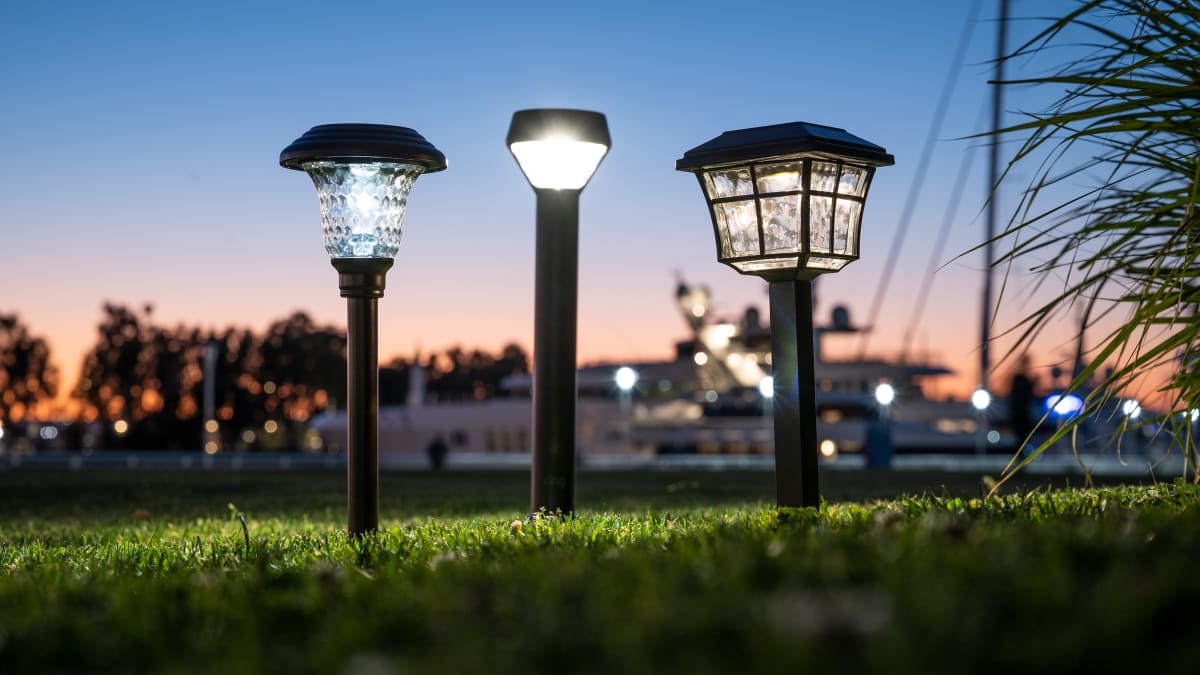The best outdoor solar lights add both beauty and safety to your landscaping. Of all the options to add lighting and ambiance to your outdoor space, one of the simplest and most affordable is solar-powered pathway lights.
Not to be confused with outdoor string lights or fairy lights, solar lights sit on stakes in the ground and charge by sunlight during the day to illuminate your yard all night. Solar landscape spotlights can be used to mark walkways, highlight decorative features, detect movement, or serve as focal design elements in their own right. Plus, their use of Solar panels means they don’t require wiring or cost extra money to run.
We put some of the most popular outdoor solar light systems through a series of tests and found the Beau Jardin Solar Lights
(available at Wayfair)
to be the best solar light overall for its durability and attractive design. If you want to splurge, the Ring Solar Pathlights (available at Amazon) are a truly spectacular smart set that are well worth the cost.
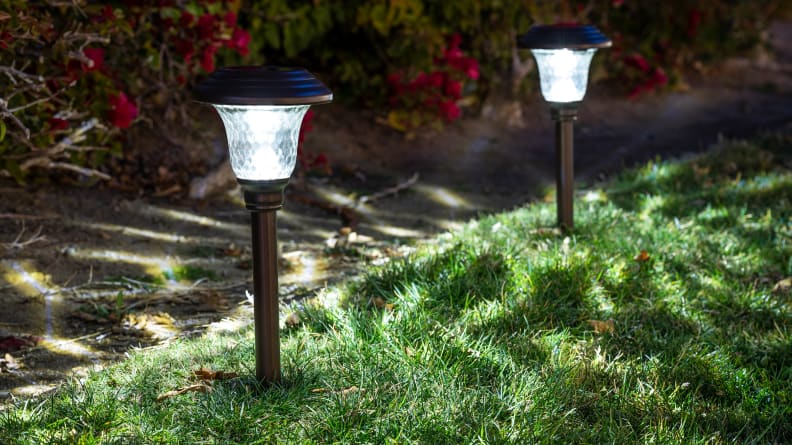
Credit:
Jackson Ruckar

These Beau Jardin Solar Lights are durable and did well with even minimal sunlight.
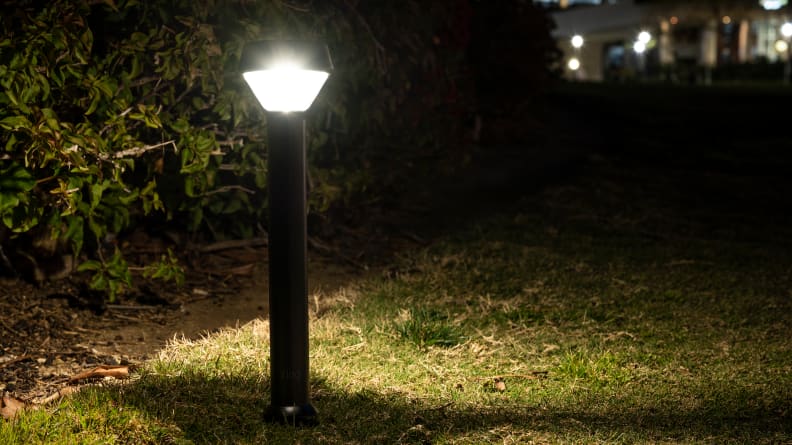
Credit:
Jackson Ruckar

Ring’s Solar Pathlight are motion activated which helped extend their battery life.
Other Solar Lights We Tested
What to Consider Before Buying Outdoor Solar Lights
Type of Solar Lights
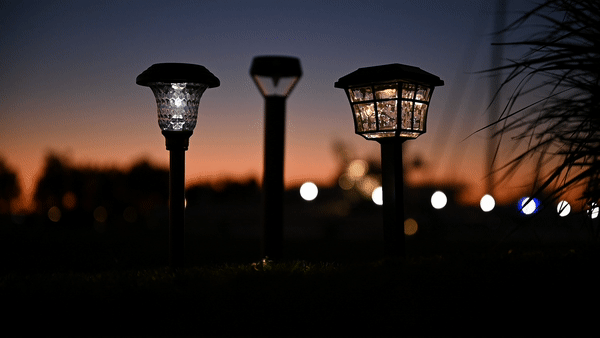
Credit:
Reviewed / Jackson Ruckar
Outdoor solar lights provide light where your power source won’t reach.
There are a variety of solar lights to meet the needs of any space. Pathway lights, like the ones we tested, are excellent for providing safety and visibility to a walkway or driveway. Solar post lights, fence lights, and rope lights can provide the same type of illumination with a slightly different look.
Solar string lights (also known as fairy lights or decorative hanging lights) are typically used more for aesthetics than pure functionality, and can help set the mood of any backyard party.
No matter what form your solar lights take, there are options for motion detection, light colors, and more to truly suit your needs.
Brightness
Light brightness is measured in lumens—the higher the lumens, the brighter the bulb. A 100-watt incandescent light bulb can measure approximately 1,500 lumens, while lights designed for outdoor use are typically much lower. Those we tested ranged from 1 to 80 lumens per bulb.
Special Features
While most outdoor solar lights are pretty straightforward, a few have special features that you may want to consider.
Some have the ability to change colors, giving you more control over the aesthetic of your yard-scape. Others may be smart outdoor lights with wireless features and lighting modes that can be controlled from your smartphone or tablet.
Still others have motion detectors, so they only turn on when needed, rather than shining from dusk to dawn. Whether or not you need any special features can help narrow your decision down.
Frequently Asked Questions
How Do Solar Lights Work?
Solar lights have a photovoltaic panel on the top of the light that converts sunlight into electricity that then powers a rechargeable battery inside the lantern.
An internal light sensor recognizes when night has fallen, and the LED light or lights turn on, running off of that rechargeable battery. When the sun comes out again, the battery charges back up to full, ready to power another night.
Do Outdoor Solar Lights Need Direct Sunlight?
Most solar lights function best and charge fastest in direct sunlight. However, all but two of the lights we tested worked in our indirect sunlight tests.
Shade or cloudiness may affect how long it takes the battery to charge. But as long as the battery gets full during the day, a good light should work fine that night.
Do Solar Lights Work In Winter?
From a purely electrical standpoint, solar lights will gather sunlight and charge the battery in the cold. However, not all of the lights that we tested were able to stand up to the environmental rigor of New England winter weather. Several models grew noticeably dimmer and even failed after two weeks of rain, ice, snow, and freezing temperatures.
If you live in a cold environment, consider investing in higher-quality lights.
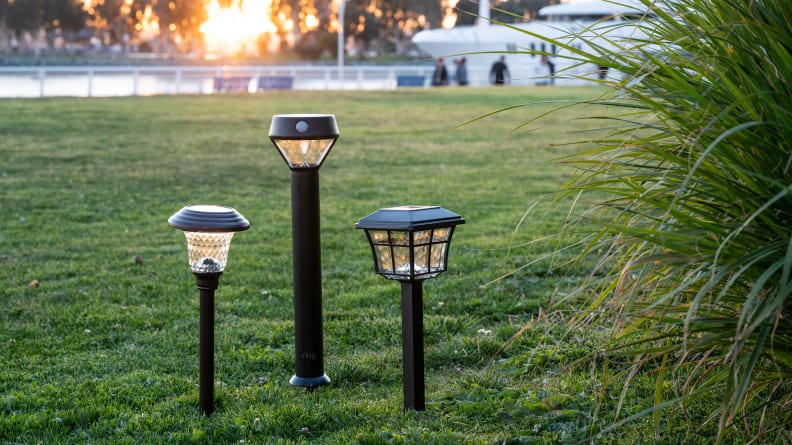
Credit:
Jackson Ruckar
Most of the outdoor solar lights we tested worked in direct or indirect sunlight.
How Long Do Outdoor Solar Lights Last?
For single-day performance, some lights we tested lasted 8 to 12 hours, and even far longer in some cases.
For long-term durability, we tested our solar lights over two weeks of a New England winter—a worthy test, but we can’t say definitively how long all of them will last over time.
However, there is a wide range of quality in the market. Some of the lights we tested never really worked, others started to fail after a few weeks, and still others show no signs of wear or slowing down.
I would expect any of our top-ranked lights to last for at least several years, until the rechargeable batteries themselves fail.
Are Outdoor Solar Lights Durable?
In testing, solar light durability came down almost entirely to the materials that the lights were made of. Lights made primarily of plastic crack very easily. The ones made of glass and metal are much more durable, both in terms of their physical durability and their ability to stand up to the weather.
In terms of their ability to slide into the ground, they nearly all use a similar plastic stake. Lights with cylindrical stands are a bit flimsier than the lights with square stands.
How Bright Are Solar Lights?
Some solar path lights are designed to give off a very dim glow, and function more as markers than true light sources. They’d help you see the edge of a walkway, but you probably couldn’t use the lights to find your keys if you dropped them.
Other solar path lights give off a usable amount of illumination, so that you could light up most of your yard with a few of them.
Still others, like the Ring light, are more like spot-lights on a stake. The light output from a single powerful light covers my entire walkway area. This may be too much bright light for some uses. In that case, look for the option to adjust brightness or shop for something more subtle.
How We Evaluate the Best Solar Lights
For the original version of this guide, we ran a series of tests designed to put each solar light through various real-world scenarios to find out how they’d hold up. Of that initial round of testing, a few products ultimately just weren’t up to snuff. So we’ve done additional research—based on a variety of factors such as user reviews, durability, and product specifications—and included some solid alternatives to go with our initial top picks. (The Beau Jardin and Ring Solar Pathlights were tested.)
Our first test for the solar path lights was basic assembly. We found that all of the lights fit together in pretty much the same way, and can be set up in under five minutes. However, some are more durable than others. During assembly, we checked the sturdiness of the materials, taking note of any that broke or cracked during assembly.
Once the lights were assembled, we inserted them into a bucket of sand to find out how well they stood up to being inserted into the ground. We chose to use sand because we tested in the winter when the ground was frozen.
The next test was to find out how well they charged in both direct and indirect sunlight. We placed one of each type of light in direct sunlight, and another of each in a part of the yard that rarely gets any sun.
We waited for the lights to charge, checking to see if they were able to charge in a day. We also set up a third batch of lights to fully charge and then placed them in a dark basement, checking every few hours to see how long the fully charged lights lasted.
Finally, we moved into durability testing. First, we gently kicked each of the lights several times, looking to see if it would crack, stop working, or fall over. We then poured water over each of them to simulate wet weather conditions. Mother Nature helped with this test as well, providing both a blizzard and an ice storm as additional tests.







